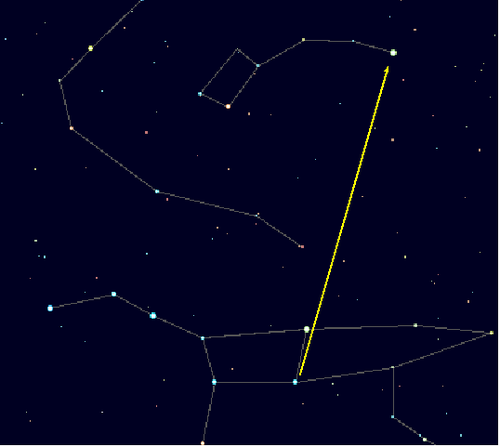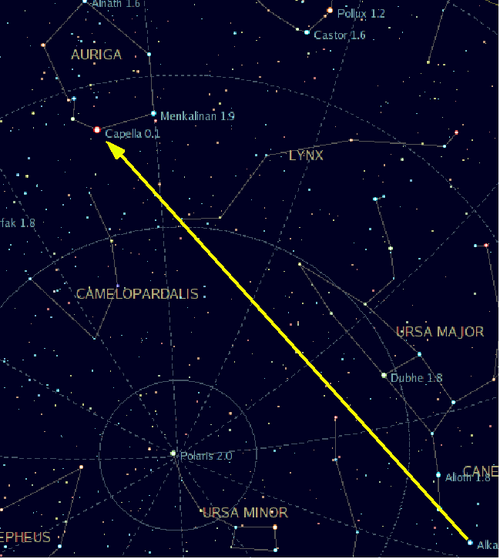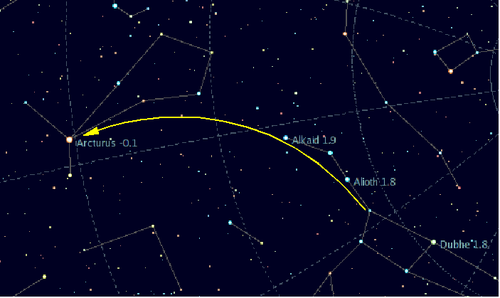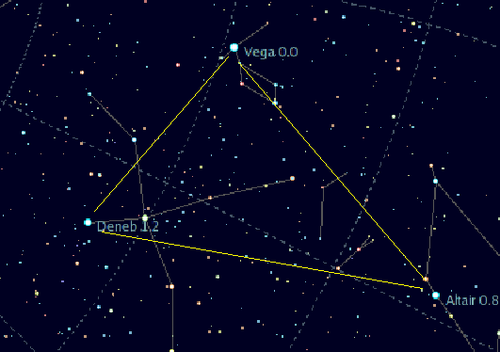Difference between revisions of "AY Honors/Stars/Answer Key 2/es"
(Created page with "</noinclude> Una estrella fugaz no es una estrella en absoluto, sino más bien un meteorito. Un meteorito es cualquier cuerpo celeste (usualmente bastante pequeño) que cae a...") |
(Created page with "Descubra más con la especialidad de Meteoritos") |
||
| Line 42: | Line 42: | ||
Una estrella fugaz no es una estrella en absoluto, sino más bien un meteorito. Un meteorito es cualquier cuerpo celeste (usualmente bastante pequeño) que cae a la tierra. La mayoría se queman en la atmósfera antes de llegar a la superficie, dejando una raya brillante y de corta duración en el cielo. | Una estrella fugaz no es una estrella en absoluto, sino más bien un meteorito. Un meteorito es cualquier cuerpo celeste (usualmente bastante pequeño) que cae a la tierra. La mayoría se queman en la atmósfera antes de llegar a la superficie, dejando una raya brillante y de corta duración en el cielo. | ||
| − | + | Descubra más con la especialidad de [[AY Honor/Meteorites/es|Meteoritos]] | |
<noinclude></noinclude> | <noinclude></noinclude> | ||
Revision as of 01:14, 1 March 2021
| Cosmografía | ||
|---|---|---|
| División Norteamericana
|
Destreza: 2 Año de introducción: 1928 |
|
Requisitos
Las mareas se rigen por la luna, y en una manera menor, por el sol.
Un eclipse se produce cuando el sol, la tierra y la luna están en una línea directa entre sí. Cuando la tierra está entre el sol y la luna, se ve un eclipse lunar, que es la sombra de la tierra cayendo sobre la luna. Cuando la luna está entre el sol y la tierra, se ve un eclipse solar, que es cuando la sombra de la luna cae sobre la tierra (bloqueando el sol).
Una estrella fugaz no es una estrella en absoluto, sino más bien un meteorito. Un meteorito es cualquier cuerpo celeste (usualmente bastante pequeño) que cae a la tierra. La mayoría se queman en la atmósfera antes de llegar a la superficie, dejando una raya brillante y de corta duración en el cielo.
Descubra más con la especialidad de Meteoritos
Place the "sun" model in the center. Place the "earth" some distance from the sun, and show how it travels in a near circle around the sun. The moon travels around the earth, but it always shows the same face to the earth (it's rotation on its axis takes the same amount of time as its orbit around the earth.
Light travels at 186,000 miles per second (not miles per hour), or 300,000 kilometers per second. In one year, light will travel 5.88 trillion miles (9.4 trillion km). This distance is also called a light-year. How far is that?
Earth orbits the sun at an average of 92,955,807 miles (149,597,870 km). This distance from Earth to the sun is called an astronomical unit, or AU. It takes light from the Sun about 8 minutes and 20 seconds to cover the distance from the Sun to the Earth. There are 63,239 AUs in a light-year since light can travel 63,239 times further in an Earth year than it takes to get from the Sun to Earth.
AUs are easy to work with in our solar system. Jupiter, for example, is 5.2 AU from the Sun or 5.2 times further from the Sun than the Earth is, while Neptune is 30.07 AU from the Sun.
However, when you move outside our solar system the distances get much larger. The distance to the nearest star, Proxima Centauri, is about 268,770 AU and the numbers get bigger from there. To express such long distances, astronomers use the light-year. At 63,239 AU to the light year, that closest star Proxima Centauri is about 4.25 light-years away, which means it takes 4.25 of our years for its light to reach our eyes. When we star gaze we are really looking back in time.
In 2016 scientists announced they found a galaxy they called GN-z11 which they estimate is 32 Billion light-years away. If you ever wondered if God and his creation is really eternal without beginning or end, think about the fact God created a galaxy before 32 Billion years ago.
The word planet means wanderer because the planets appear to wander about the sky relative to the stars. The stars do not move in relation to one another (although they all appear to move together because of the Earth's rotation on its axis).
Which eight stars you choose to teach your Pathfinders to identify will depend on the season (spring, summer, winter, or fall), although some stars are visible year-round.
Stars visible in the Northern Hemisphere
Polaris
Polaris is one of the most useful stars for a person in the Northern Hemisphere to be able to identify, as it can tell you two things: which way is north, and what is your latitude (if your latitude is 38°, Polaris will be 38° above the horizon).
Capella
Capella can be found by following the line made by the two stars in the Big Dipper's handle and extending it across the Dipper's bowl.
Arcturus
Arcturus is the brightest star in the constellation Boötes, and the third brightest star in the night sky. Arcturus can be found in the summer by following the arc made by handle of the Big Dipper (away from the dipper's bowl).
A constellation is any one of the 88 areas into which the sky - or the celestial sphere - is divided. The term is also often used less formally to denote a group of stars visibly related to each other in a particular configuration or pattern.
- Ursa Major
- Ursa Major is better known as the Big Dipper. It appears in the north and is fairly easy to identify. It is illustrated in a previous requirement.
- Ursa Minor
- Ursa Minor is better known as the Little Dipper. Use the instructions given previously for finding Polaris, which is the end of the Little Dipper's handle. Unfortunately, the stars that make up Ursa Minor are relatively dim, making this one a bit more difficult to find.
- Cassiopeia
- Cassiopiea is illustrated in the next requirement and is generally visible (at some time during the night) all year round. It is on the opposite side of Polaris from the Big Dipper.
- Boötes
- Instructions for finding Arcturus, and thus the constellation Boötes are given in a previous requirement.
- Cygnus, Altair, and Lyra
- These are easily identified summer constellations. The brightest stars in each of these three make up the Summer Triangle. Once the stars are found, it is easy to find the constellations they are part of. Vega is the brightest star in the Summer Triangle, and it is a member of the constellation Lyra. Cygnus is also known as the Northern Cross. The triangle is completed by Altair which is a member of the constellation Aquila.

The Winter Circle is made up of several bright stars visible in the Northern hemisphere's winter. The easiest constellation to find in the Winter Circle is Orion. Following Orion's belt will lead to Sirius, the brightest star in the sky and a member of Canis Major (the "big dog"). Canis Minor (the "little dog") is clockwise from Sirius. Continuing clockwise, we come to Gemini, Auriga, and Taurus.
The constellations that are visible throughout the year are the ones near the celestial poles: Adventist Youth Honors Answer Book/Stars/Constellations visible all night
Adventist Youth Honors Answer Book/Stars/Big Dipper, Cassiopeia, and the North Star
Adventist Youth Honors Answer Book/Stars/Southern Cross, Orion and Scorpio
A large gathering of stars and bodies making up one of many galaxies. The portion visible in the night sky of Earth is only a single dimensional or flat view of the galaxy as our solar system is part of the same galaxy we have lack for a broader perspective.
This is not a star at all but the planet Venus and draws in part its modern status as the Morning Star and Evening Star from mythology. Venus never appears on the opposite horizon from the sun because its orbit lies inside Earth's orbit (that is, its orbit is closer to the sun that the earth's orbit). Mercury too fits this profile but since it is even closer to the sun than Venus, it is only visible briefly before sunrise or just after sunset.
Zenith is the point in space directly overhead. If you extend a line from the zenith to the point on Earth upon which you are standing, and continue that line through the Earth and out the other side, it would point to the nadir. In other words, nadir is the direction pointing directly below a particular location. The line connecting the zenith and nadir passes through the point on Earth where you're standing and also passes through the center of the Earth and out the other side.
An Aurora is a beautiful natural phenomenon that often occurs in the polar regions of Earth.
The immediate causes of aurora are precipitating energetic particles. These particles are electrons and protons that are energized in the near geospace environment. This energization process draws its energy from the interaction of the Earth's magnetosphere with the solar wind.
- "December 16, 1848, the Lord gave me a view of the shaking of the powers of the heavens. I saw that when the Lord said heaven, in giving the signs recorded by Matthew, Mark, and Luke, He meant heaven, and when He said earth He meant earth. The powers of heaven are the sun, moon, and stars. They rule in the heavens. The powers of earth are those that rule on the earth. The powers of heaven will be shaken at the voice of God. Then the sun, moon, and stars will be moved out of their places. They will not pass away, but be shaken by the voice of God.
- Dark, heavy clouds came up and clashed against each other. The atmosphere parted and rolled back; then we could look up through the open space in Orion, whence came the voice of God. The Holy City will come down through that open space. I saw that the powers of earth are now being shaken and that events come in order. War, and rumors of war, sword, famine, and pestilence are first to shake the powers of earth, then the voice of God will shake the sun, moon, and stars, and this earth also. I saw that the shaking of the powers in Europe is not, as some teach, the shaking of the powers of heaven, but it is the shaking of the angry nations.” – Passages from Ellen G. White Early writings, page 41
The above statement clearly mentions the events that would occur during Christ’s second coming to this earth. The passage also mentions that God’s voice would be heard through the open space in the Orion and also the “New Jerusalem” would descend from that open space. It is in agreement with the Holy Bible in Revelation 3:12 “Him that overcometh will make a pillar in the temple of my God, and he shall go no more out: and I will write upon him the name of my God, and the name of the city of my God, which is New Jerusalem, which cometh down out of heaven from my God: and I will write upon him my new name.”
The same is also mentioned in the book of Revelation, chapter 21:2 & 3 “And I John saw the holy city, New Jerusalem, coming down from God out of heaven, prepared as a bride adorned for her husband. And I heard a great voice out of heaven saying, Behold, the tabernacle of God is with men, and He will dwell with them, and they shall be His people, and God Himself shall be with them, and be their God.”
The passage also mentions on many things that would happen at the end of time whereby it affects nature terribly and also war between world countries with no more peace and safe place for humans.
References
International Astronomer's Union [1]
Notes
On August 24, 2006 the International Astronomers Union, a non-governmental entity, reclassified Pluto giving it the status of Dwarf Planet. This new classification is based on their updated definition of what a planet is. One reason for the change is because the new definition requires that a planet "dominate" its orbit. Pluto's orbit crosses and is dominated by Neptune. Furthermore, scientists are discovering that the region of Pluto's orbit, which is known as the Kuiper Belt, is similar to the asteroid belt. There are many Pluto-like objects in that region, including one named Eris which is very nearly as large as Pluto. This means Pluto is more like an asteroid than it is like a planet.
- Categoría: Tiene imagen de insignia
- Adventist Youth Honors Answer Book/Honors/es
- Adventist Youth Honors Answer Book/es
- Adventist Youth Honors Answer Book/Skill Level 2/es
- Categoría: Libro de respuestas de especialidades JA/Especialidades introducidas en 1928
- Adventist Youth Honors Answer Book/North American Division/es
- Adventist Youth Honors Answer Book/Nature/es
- Adventist Youth Honors Answer Book/Nature/Primary/es
- Adventist Youth Honors Answer Book
- Adventist Youth Honors Answer Book/Do at home





